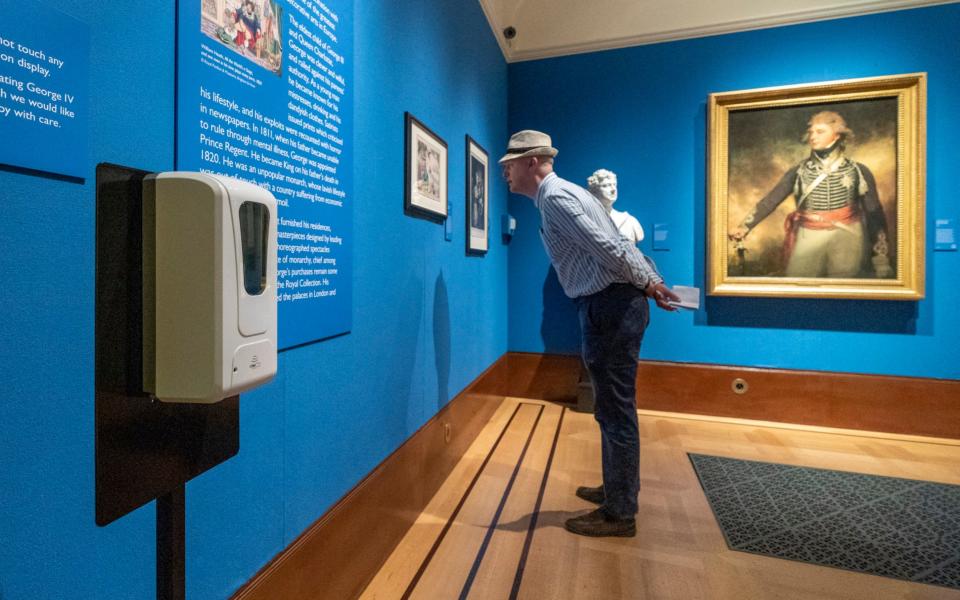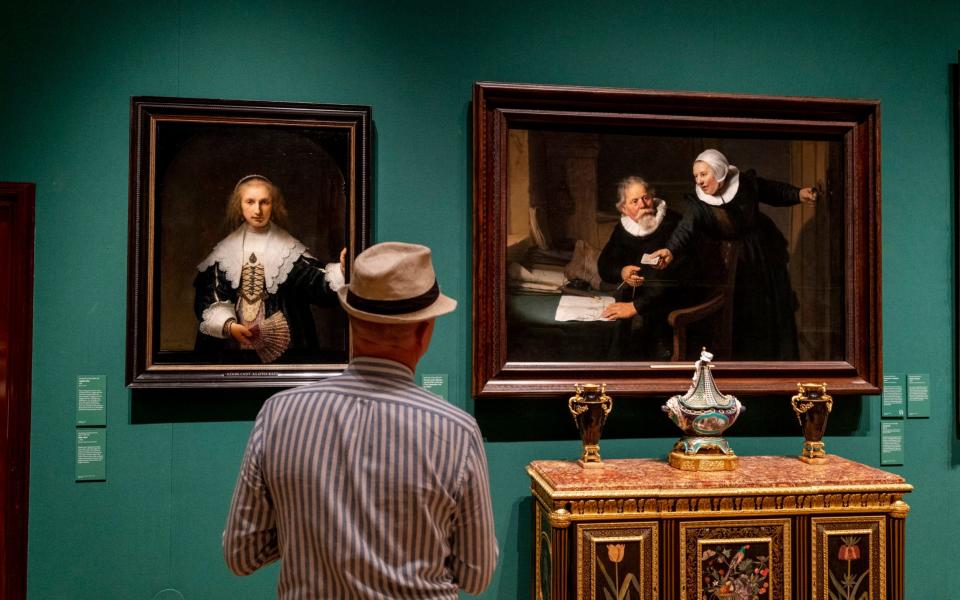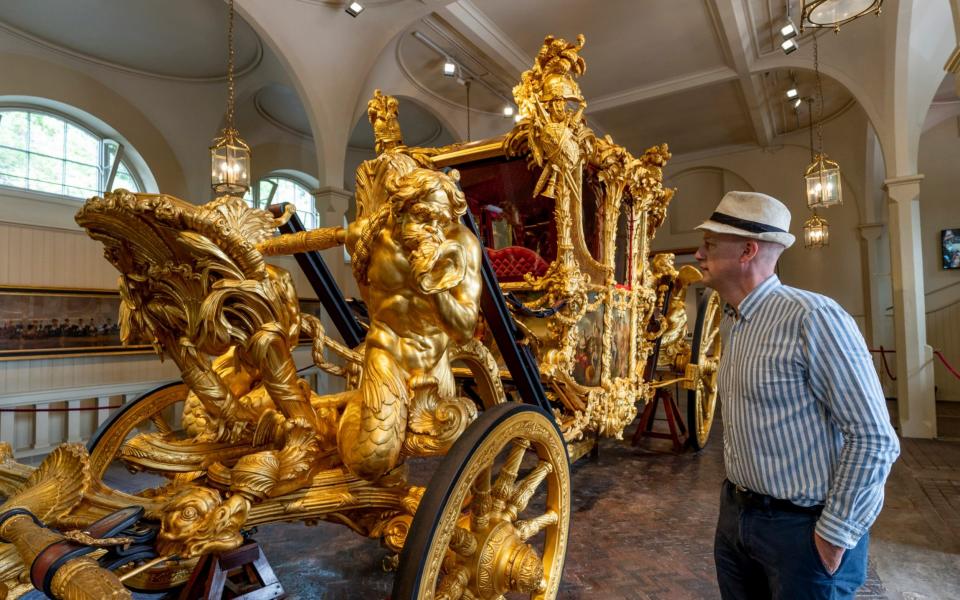My day out at the reopened Buckingham Palace was wonderful for the post-lockdown soul

Not since the end of the war has a summertime in royal London seemed so empty.
As I bicycled up the Mall towards Buckingham Palace, I had the majestic, broad, pink road entirely to myself. Outside the Palace, a dozen tourists stared through the railings at the Queen-free building – Her Majesty has been isolating in a royal ‘bubble’ with Prince Philip at Windsor Castle throughout lockdown.
Buckingham Palace isn’t opening to visitors as usual this summer; the State Rooms are expected to take guided tours again in the winter. But the Royal Mews at the Palace and the Queen’s Gallery next door reopened on Thursday – as did Windsor Castle, the Palace of Holyroodhouse, the Royal Mews and the Queen’s Gallery in Edinburgh.
And now is the time to visit. There were only a couple of dozen tourists at the Royal Mews and even fewer at the Queen’s Gallery.
Now you can see the Queen’s marvellous art collection, her state coaches and her horses just as she does herself, in splendid royal isolation. Gone are the crowds of tourists, the noise and bustle – and the queues! There was no queue at all at the Queen’s Gallery. There was a queue at the Mews… but it numbered just two people, a British couple. For the first time in living memory, the majority of tourists’ voices I heard at the Palace were English.
Subtle social-distancing measures have been introduced, but there were so few people there that I hardly noticed them.
You travel round the Royal Mews in a one-way system and both the Mews and the Queen’s Gallery are liberally sprinkled with hand-sanitiser dispensers. You can only use one in every two of the sinks in the loos at the Queen’s Gallery, but that hardly mattered – I had the royal conveniences to myself.

From July 24, you are obliged to wear a mask in the royal shops, to go along with Government rules, but elsewhere, masks are only suggested. The staff all wear visors, but I only saw one tourist in a mask in my two hours there. The visitors were a self-selecting, robust group who treasured art and history more than they worried about the plague.
Also – and this is crucial – you can only come on a pre-booked ticket, in order to manage numbers which have been reduced thanks to virus measures. Going on Thursday's attendance, tickets for the moment are in liberal supply but, still, better to be safe than sorry.
How wonderful it was for the post-lockdown soul to see such beautiful pictures, furniture and horses in such historic surroundings. And in such extraordinary condition. Every single object has been dusted – or groomed – within an inch of its life during lockdown. After the Royal Collection has been closed for so long – like galleries across the country – I began to realise quite how lucky we are to have it at all.
As Prince Charles, Chairman of the Royal Collection Trust, said in a welcoming message to herald the opening of the collection and the palaces, “2020 has been a year unlike any other and, as we emerge from months away from loved ones and trying times, I’m delighted that we can start to look forward to enjoying so many of the things that we might have taken for granted before: the joy of art, learning new things, exploring magnificent buildings are all at the heart of what the Royal Collection Trust is about and, as Chairman, I look forward to you being able to visit one of Her Majesty the Queen’s official residences once again.”
It helps, too, that the show on at the Queen’s Gallery, George IV: Art & Spectacle, is a cracker!

George IV might have been a lusty, roguish Prince Regent, with his generous taste for mistresses and waist-expanding mammoth meals. But he was also an aesthete, responsible for commissioning John Nash to build the fantastic onion domes of Brighton’s Royal Pavilion. (Nash, together with Sir William Chambers, also built the elegant, enormous stables of the Royal Mews.)
George IV had an extremely good eye for a picture. At the Queen’s Gallery, I stared, alone, at the two exceptional Rembrandts he bought. He acquired a portrait of sombre Agatha Bas for 800 guineas. And he got Rembrandt’s double portrait, The Shipbuilder and his Wife, for 5,000 guineas – a fortune at the time, 200 years ago, but an incredibly shrewd buy, bearing in mind Rembrandt’s value today. He bought the pictures to decorate his youthful home in Carlton House, Pall Mall – a nice way to fill your walls.
Elsewhere in the Queen’s Gallery, you’ll see the other commissions and favourite pictures of George IV: several Rubenses and Cuyps, a light, joyful Gainsborough portrait of his three princess sisters, Charlotte, Augusta and Elizabeth, and a Jan Steen. And then there’s George IV’s French porcelain, goldsmiths’ work and his favourite books and drawings
Also on show are the Waterloo Chamber portraits George IV commissioned from Sir Thomas Lawrence to celebrate the Battle of Waterloo. Here are the great, wily statesman Metternich and Pope Pius VII. A bust of the hero of Waterloo, the Duke of Wellington, stares down at the gallery, a few steps from a John Hoppner of Nelson a few years before the Battle of Trafalgar.
If you want a crash course in British history, this exhibition is a pretty good bet. And, thank God, the Queen doesn’t go in for ‘cancelling’ the historical heroes of yesteryear. The captions to the pictures and furniture are a model of scholarship and good sense.
If you’re more interested in the day-to-day life of the Queen, the Royal Mews, just next door to her gallery, is the place.
The Royal Mews goes all the way back to Richard II in the 14th century. He kept his hunting falcons and hawks at Charing Cross, where they would ‘mew’ – or lose – their feathers.
When George III bought Buckingham Palace in 1761, he moved the mews there. And it’s been there ever since. It’s now home to over 70 of the Queen’s horses – Windsor Greys and Cleveland Bays – which she names herself. Looking as sleek and calm as you like yesterday were Zeno, born in 2009, and Firework, a lovely, gentle 22-year-old veteran of the stables.
The highlights of the mews are the Gold State Coach, the grandest of all the coaches, commissioned by George III in 1762 and used at every coronation since George IV’s in 1821. The four-tonne gilded behemoth needs eight horses to draw it.

A short walk away is the ultra-blingy, newest of the Queen’s coaches, the Diamond Jubilee State Coach, made in Australia in honour of the Diamond Jubilee in 2012 and first used in 2014, at the State Opening of Parliament. It’s the Queen’s most comfortable coach, unlike the suspension-free older models.
The Royal Mews at Buckingham Palace is responsible for all the road travel arrangements for the Queen and Royal Family. So you’ll also find one of her majestic Daimlers here, along with Queen Victoria’s donkey barouche, used at Windsor by Prince Andrew and Prince Edward as children, and the royal sleigh for Christmas parties.
What a unique potpourri of royal oddities and masterpieces. And how much more incredible they seem with no crowds, after three months behind closed doors.
George IV: Art & Spectacle is at The Queen’s Gallery, Buckingham Palace. Bookings: rct.uk. Harry Mount is author of How England Made the English (Penguin)

 Yahoo News
Yahoo News 